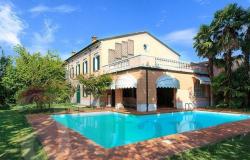 Mantua is joining festivities marking the 600th anniversary of Leon Battista Alberti's birth with a major show taking place at the house of another Renaissance great, Andrea Mantegna.
Mantua is joining festivities marking the 600th anniversary of Leon Battista Alberti's birth with a major show taking place at the house of another Renaissance great, Andrea Mantegna.
Alberti is widely considered to be the embodiment of the universal ideals of Renaissance humanism and is, in many respects, the precursor of Leonardo da Vinci.
More than 100 designs, manuscripts, models and original architectural decorative components have been brought together for the show, which will focus on Alberti's theories on architecture and his accomplishments as practitioner of the art.
The show, which opens on September 16 and runs until January 14, also includes several paintings and statues which curators say will help visitors understand his influence on artists he inspired, including Donatello, Beato Angelico and Botticelli.
The tribute to Alberti flanks another that Mantua is dedicating to Mantegna on the 500th anniversary of his death. The Mantegna show, at Palazzo Te, charts the painter's immense contribution to the city's cultural Renaissance in the 15th century.
The two exhibits will also place the spotlight on the wordly Gonzaga court - which brought both Alberti and Mantegna to Mantua - and show that artistically it rivalled those in Florence and Milan, historians said.
Alberti, who was born in Genoa in 1404 and died 68 years later, was a musician, writer, painter, architect, mathematician and philosopher.
Many rank him alongside Filippo Brunelleschi as one of the 15th Century's greatest architect. His treatises on painting (Della Pittura) and sculpture (De Sculptura) helped set the course of Renaissance art, while the buildings he designed and his treatise on architecture (De Re Aedificatoria) was fundamental in restoring the language of classical architecture.
Split into ten volumes, De Re Aedificatoria presents Alberti's vision of the art of architecture and remainedhighly influential until well into the 18th century.
Alberti was born out of wedlock to a family of Florentine merchants, who had been forced into exile in Genoa for political reasons.
His father, however, recognized him as legitimate.
After studying in Bologna he opted for a career in the church. This allowed him to indulge his love of study and develop his many talents while moving between Ferrara, Bologna, Florence, Mantua, Rimini, Urbino and Rome. Between 1433 and 1441 he wrote many of his best-known
works, including De Pictura (1436), in which he set figurative-art rules on perspective, proportion, light,colour and the composition of the 'story' a work tells.
From the 1450s onward he worked as an architect, mainly in Florence, Rimini and Mantua, which boasts the churches of Sant'Andrea and San Sebastiano in Mantua, widely regarded as the culminating achievement of his architectural career.



